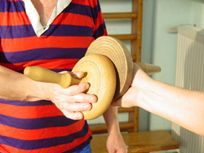I.7.1. History of the sport
This sport has a history of more than 100 years. The Turul Game, an amusing game, which was also affordable for the less wealthy members of society, started out on the bank of the river Tisza, in Szeged, Hungary. The rules of the game were first published in 1903 by Antal Halácsy, a fencing master and physical instructor. With the support of the Hungarian Gymnastics Club, he attempted to make the game popular in other towns of the country, but it gained significant popularity only in its hometown.

60 years of Turul, also known as “volley tennis”
The Turul Game received the name “volley tennis” in the 1950s. In this fast-paced game, the ball had to be hit directly with a wooden racket, which resembled an old seal stamp. Its rules were constantly changed and modified during the decades to become the ones we use today. Its most important rules were compiled by István Thékes in 1958. The racket was also reshaped to make it a really amusing game. At this time, a lot of people enjoyed this sport in Szeged, and crowds were playing with their own rackets on the riverbank as an outdoor recreational activity. As for the current tactics of the game, there were hitting-style players and defenders, who tried to prevent the ball from falling by hitting it from below. The game required good reflexes and resulted in spectacular rallies. It was important to play it on soft ground, as the sand could prevent serious injuries while jumping to save the ball. Players waiting to join the game usually stuck their rackets in the sand and sat down on them. This was the time when the tradition of saying goodbye to the other players by touching their rackets was formed in order to show respect to each other. In the 1950s, László Thékes made considerable effort to give new impetus to the Turul Game.

Modern Turul Game today
Today’s Turul is very similar to tennis, badminton and volleyball, as it requires the same set of movements. A successful game requires proper knowledge of tactics, because particular actions must be preceded by appropriate rallies. It is a characteristic of the sport that those get the opportunity to serve, whose side the ball landed on.

The International Turul Games Organization was established int he 1990s in Nurenberg, Germany. This is the only sport in Hungary, which has an international association, but does not have a national one. The game has become known as sprintball in our country. The first official Turul World Championship was organised in Venice in 1990. The only Hungarian competitor was Attila Csorba, a teacher from Szeged, who won the competition, and became world champion in adult men’s singles. In 1992, an 8-strong team introduced volley tennis at the International Physical Education Teachers’ Conference (NTTK), in Budapest. They were István Thékes, Géza Harsányi, Gyula Kozma, Ágnes Diamant, Gyöngyi Joó, Árpád Berecz and two P.E. majors. The presentation was successful, and the game soon became popular. Since then, volley tennis forms a part of the NTTK every two years, where Hungarian and foreign colleagues also had the chance to try it. In the spring of 1994, the quadrathlon athlete Andrea Spitzer learnt and promoted volley tennis all over Europe. On August 31, 1995, the International Turul Games Organization held a world cup named Thékes Cup in memory of László Thékes in Venice. The ground was sandy, and the height of the net was 2 meters following the traditions of Szeged. Several Hungarian teams entered the competition. In men’s doubles, László Thékes’s son, István and his grandson won the championship. Since the 1990s, the sport has had its renaissance in Szeged and got a new impetus. The “great turul players” hold regular competitions every year and organize grassroots sports events on the bank of the river Tisza. Since 1994, Gyöngyi Joó, P.E. teacher has presented this long-forgotten game for Hungarian and foreign colleagues at the International Physical Education Teachers’ Conference. Between 1996 and 2005, this special Hungarian game was part of the curriculum for physical education, recreation and sports event organization majors at the Institute of Physical Education and Sports Studies of the Juhász Gyula Teacher Training College of the University of Szeged. In 2000, the 1st (unofficial) TURUL Championship was organized at the NTT Conference with 42 participants from the following countries: Italy, Belgium, Canada, Taiwan, Croatia and Hungary. On September 17, 2004, the Szeged Turul Championship was held in youth, adult and senior categories. 4 competitions are held annually in the town. This was the year when the first turul departments were established in Szeged, e.g. UTC. In July 2006, the game was also presented at the International Physical Education Teachers’ Conference in Vierumaki, Finland. The game has also become part of the Physical Education Teachers’ Picnic in Zánka. In 2004, the latest book of rules was published, which includes the history of the 100-year-old game, as well.